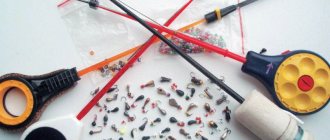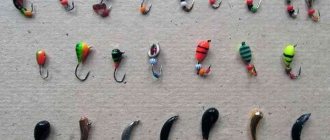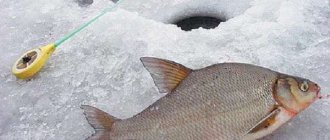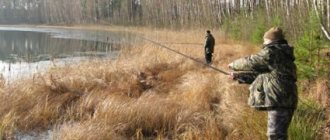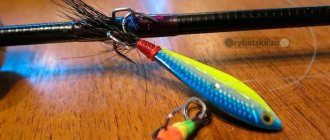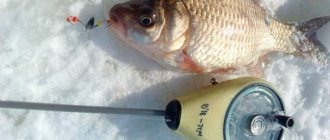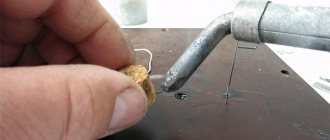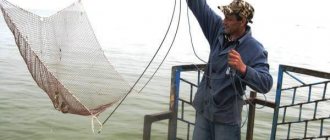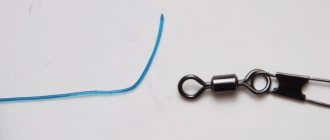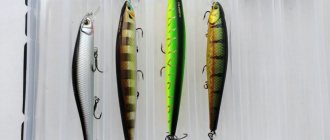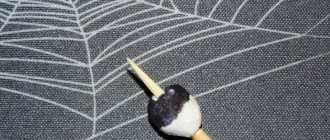The most common fish when fishing on the first ice is roach. She is omnipresent, gluttonous and capricious. The high taste of roach explains its popularity among different categories of fishermen.
A caught roach looks like a silver ingot. The average weight is 0.3−0.5 kg. Found at the boundaries of strong and weak currents. The roach is omnivorous, its main food is insect larvae, mollusks, worms, and aquatic vegetation.
The fisherman needs to know what gear and jigs to use for roach in winter so that this beautiful fish will delight you with its bites.
Tackle for catching roach in winter
Winter fishing is the cheapest to purchase gear; anyone can afford it. The simplest tackle is a winter float rod; it is the basis for all other fishing gear.
Comprises:
- fishing rod - includes a whip and a handle. A whip (rod) 20-30 cm long is inserted into one end of the handle. The handle itself must have a device for installation on ice;
- reels - micro-type reels are used; in winter fishing they only store fishing line;
- fishing line - ordinary fishing line with a thickness of 0.05 to 0.15 mm. Only in the presence of large fish is it increased to 0.18 mm;
- float - light and sensitive, up to 25 mm in size, the upper part is painted red for easy observation of the bite;
- hook N3−3.5 with a particularly sharp sting.
A winter float rod can provide a catch even in the dead of winter, especially if you bait a suitable hole. Hooking the fish is done only by a rod; it is fished with a special fishing line, which is handled by hand.
The second gear for fishing from ice is a nodding rod for fishing with a jig in winter. This fishing rod has a special system - a nod and jigs for winter fishing. The nod is a bite alarm attached to a fishing rod. It is made of plastic, rubber or steel and is up to 10-15 cm long. The nod must retain its functionality in any frost.
How to choose jigs for roach
The most catchy jigs for roach for winter fishing are:
- pellet - a weight with a soldered hook;
- "bug";
- "triangular";
- "Ural";
- "ant".
Jigs for catching roach in winter are small in size, usually from 3 to 5-7 mm. The coloring is always bright and is designed to attract fish from a distance and are equipped with different baits.
As you know, roaches are especially active on the first ice. Fishermen, in addition to jigs with attachments, also use jigs without attachments, the so-called reelless jigs. Their names speak for themselves:
- “devil” is ordinary;
- "devil" compound;
- "ant";
- "butterfly".
- “goat” - has a double hook;
- “jellyfish” is a small jig with one hook.
Read: Mormyshka devil
To successfully catch fish, you need to understand its diet. The main delicacy is mormysh - an amphipod crustacean. This is where the name of this part of the winter fishing gear comes from. In summer it is found on plants, and in winter, due to lack of oxygen, it attaches to the bottom of the ice. When moving, all living creatures create vibrations in the water, which are caught by fish.
The pain of choosing a jig for roach
Today we offer the topic: “the agony of choosing a jig for roach” from professional fishermen. We tried to cover the topic as fully as possible. You can ask all questions in the comments after the article.
If we are going on winter fishing with a jig, then in more than 70 percent of cases we will have to fish for roaches. The remaining percentage will be distributed among perch, crucian carp, bream and other fish. Therefore, when buying or making jigs for catching roach, we are actually putting together a set of baits for any type of fish.
Jigs for roach are made from various materials, namely:
- Lead. The most popular material, products made from it are cheap and have an average weight, and you can make them yourself. Lead jigs are used at depths of up to five meters; in deeper places, use is difficult due to the long descent to the bottom.
- Tungsten. Unlike lead, the specific gravity of this material is much higher, which allows products made from it to have more weight of the same size. Therefore, even a small pellet quickly sinks and reaches its “consumer”.
- Tin. A jig for roach made of this metal is the lightest; they are rarely found on sale, but at home they can be easily made by any fisherman familiar with a soldering iron. Tin baits are used at depths of up to two meters.
- Plastic. Such artificial flies are attached to the leash of a fishing rod for the current or work in combination with the sinker of a float winter fishing rod. They are often coated with phosphorescent paint and used at depth.
In order to outwit and catch a winter sorog, you need to offer it the best bait, and the fish can be capricious and choose new models at different times. It is unknown which jigs for catching roach will work for tomorrow’s fishing, so you need to take the entire kit with you, which may include the following:
In addition to these generally accepted models of baits, there are other forms, and taking into account the imagination of our fishing home-made craftsmen, the number of their variations exceeds all reasonable limits.
The main purpose of such baits imitating animal food is used in reeling for roach; for fishing with bait, the simplest models are often sufficient: pellets or drops.
Roach jigs can be attached to fishing line in two ways:
- for a ring;
- through the body behind the forend.
In the first case, the position of the bait is strictly vertical, in the second it is determined by the angle of the hole in the body and the method of attachment.
Tying by the ring is done with a clinch or palomar type knot. Attaching jigs with a hole in the body is carried out in different ways:
single knot for thin holes;
double knot is similar to single knot;
whip knot, as for hooks with a ring;
cast-on loop, at the end of the fishing line threaded into the hole, a regular loop is knitted and thrown onto the hook.
Although many authors argue that the main thing in a jig for roach is its shape and the play of the fisherman’s hand, color often plays a decisive role. In addition to natural metallic colors:
- silver;
- golden;
- gray;
- and reddish
baits are painted by manufacturers in different colors. Even green, an unexpected color for winter fishing, can work on a certain day, an example from personal experience.
For example, more catchy jigs for roach on a cloudy day or at great depths are light colors, in sunny frosty weather in shallow water - dark colors.
To increase the catchability of jigs for roach, their hooks are equipped with various elements, for example:
- beads;
- cambrics;
- woolen threads;
- in chains;
- hanging hooks;
- feathers.
Often the hanging elements of jigs for roach are combined together, for example, a bead and hair, a chain and a cambric can be combined in one bait. Basically, reelless baits are equipped with additional elements.
The catchability of both a reelless bait for roach and a regular bait is increased by installing a bead on a fishing line above it. When playing with a fishing rod, the bead moves along the fishing line, attracting fish.
An important factor when choosing a reelless bait for roach is the weight of the bait. Not only its game depends on this, but also the choice of fishing line and nod. A light bait on a thick line will take a very long time to sink, and a heavy bait on a light line will not give the desired game.
The nods are also adjusted at home to a certain weight of the jig, so before going fishing it is advisable to mark both the nods and the baits.
Catching roach with a jig at different depths will be more comfortable if you choose the right weight of the bait. The optimal ratio of depth to mass is approximately this:
- depth up to two meters – 0.3-0.5 grams;
- four to five meters – 1 gram;
- over five meters – 1.2-1.5 grams.
As mentioned above, it is optimal to use tungsten products at great depths, and lead products in shallow places.
No specialist can give precise recommendations on choosing the optimal nod for catching roach with a jig. Due to the fact that all people are different and the gatehouses are selected “to suit their own hand,” the materials for making nods are also different:
- metal plates;
- lavsan;
- polyethylene;
- X-ray film;
- polycarbonate
Often the nods are made by the fishermen themselves and they work no worse than branded ones.
Roach with a reeler bite best on the first ice. If you want to learn how to fish with this gear, start as soon as there is ice. In the dead of winter, fishing rods baited with bloodworms or maggots work better.
The second time for baitless fishing occurs in early spring. But the last ice is quite thick, in some places up to one and a half to two meters, so you can’t drill much, and it’s better to choose fishing with groundbait and groundbait.
Before settling over the hole, you need to scout the area for the presence of fish. To do this, we drill a fairly large number of holes, 5-15 pieces, at intervals of five to ten meters. The number and frequency of holes depends on the fishing season: on the first ice five are enough, in the dead of winter sometimes even fifteen will not be enough.
Then we feed the prepared holes with a small amount of a mixture of ground crackers and food bloodworms, at the same time we check the depth of the points, while virtually drawing the bottom topography in our heads.
Having measured and fed the holes, we begin to fish them, starting from the first. By the time the last one is fed, the first roach can already reach the first one. It is best to check the holes without a nozzle, since if a sorog is tempted by a bare piece of iron, then it will definitely bite on a bloodworm.
Having identified several holes that showed the best results, feed them thoroughly and begin to fish them in turn. Having caught 3-4 roaches with a reelless reel, move on to the next hole, otherwise you can knock out the entire flock, and the next one will never come.
Feeding at a depth of up to one and a half meters is carried out by directly pouring the mixture into the hole; at greater depths, various types of feeders are used.
At the end of our review, we will describe the technique of catching roach with a jig. To effectively catch a silver beauty, you can use the following game methods:
- We smoothly lower the tackle to the bottom, and when lifting, we make light, smooth twitches of the nod at different frequencies and intervals.
- We lower the tackle with a twitch and raise it smoothly.
- We tap the bait on the bottom, causing turbidity.
- Postings with pauses of up to five seconds. We make stops at different water levels.
- Moving the jig on the bottom from side to side.
If the game is high-frequency, then you are more likely to seduce the perch rather than the roach, the same applies to sharp rises and lowerings of the tackle. Soroga loves smooth, measured movements.
Sometimes the roach is not near the bottom, but half-water or very close to the ice, this happens on days with high atmospheric pressure, so when fishing, try to play in all water horizons.
Among the fishing fraternity, there is an ongoing debate about which jig is best for catching roach from the ice. Some claim that this is a small fish, others successfully catch it with drop-shaped products, while others are quite happy with a tablet (Tula washer). In fact, there is no magic bait, and the result largely depends on how correctly the fishing place is chosen, how the tackle is assembled and what technique or techniques of the game the angler owns.
Even the most expensive jig will be powerless if the fisherman does not know how to handle it. In addition, roach is a rather capricious fish, this quality is especially evident during the cold period. Her preferences may change throughout the day, so you need to take several different models for fishing and select the catchy one experimentally. What jigs for roach for winter fishing should be in your arsenal? How to choose from the huge variety offered today in fishing stores exactly those that are tailored for catching this fish?
Features of catching roach in winter with a jig
Catching roach in winter is an opportunity to settle in places where you can’t get close in summer.
On the first ice, fish should be fished at depths of up to three meters. She tries to stay in the remaining vegetation. Roach also moves around the water area, but has its own favorite places. These are tributaries flowing into the lake. Fish is searched for by the number of holes.
When entering the ice, the angler drills a hole and begins to fish. It takes about ten minutes to find out if there are fish here. If a school is discovered and there are bites, then you also need to find out where the concentration of fish is greatest. A larger number of holes are drilled and the most catchy one is selected.
You need to behave a little differently in small bodies of water, usually overgrown with reeds. By its appearance you can determine the depth, because the reed grows no more than one and a half to two meters. It would be good to drill a hole in the reeds themselves.
The color of the jig can make a difference and should be changed. On the first ice, after this individual you need to take a “Uralka”, “ant”, “nymph”. It is better to choose dark colors. Ideally, you need to have several wormless jigs and jigs for attaching bloodworms.
In the wilderness, this species practically does not feed and reacts poorly to various baits. At this time, anglers use feeding and the smallest jigs.
Fishing tactics
In December, individuals are caught at depths. The ice is already completely covering the lakes and the fish are moving to deep places where there is food. Roach especially likes to be at changes in depth, in holes, near cliffs. Throughout the month, it shows high activity, but like all fish, it does not tolerate weather changes well. At high pressure and unstable temperature, a good bite is impossible. As soon as all this stabilizes, the fish feed again.
To improve the bite, some fishermen decorate the tackle with various beads, cambrics, and chains. Roach is very inquisitive; by combining the colors of different devices, you can significantly increase interest in the bait. Individuals prefer bright colors.
The most common tactics for catching this species are as follows. Having discovered the area where the fish should be, several holes are made. Then these holes are constantly and daily fed and sometimes the catch is decent. But gradually the fish begins to be capricious and cautious. The fishermen go to another place.
Fishing technique
When fishing for roach in winter, the techniques differ from those in summer. An experienced angler is a master of the game with artificial bait. After all, the play of the tackle depends on its shape, flow, and elasticity of the nod. The work is done with a relaxed hand, the movements themselves are done only with the hand.
Some techniques for winter roach fishing:
- the tackle is thrown to the bottom, trying to hit it or raise mud;
This can attract fish, then slowly vibrating with a nod, they lift it up 30-40 cm. Now they quickly lower it back to the bottom, the length of the pauses between these cycles is 3-4 seconds;
- slowly lowering the hook to the bottom, stretch it from side to side by 2-3 cm, then begin to lift it, stopping for 2-3 seconds;
If the water is clear, then bending over the hole, you can see the hook and the movements assigned to it. Hooking is done only with a fishing rod; fishing is done by hand. Having made the hook, the fishing line is picked up with the left hand, the fishing rod is placed on the ice, and fishing begins.
Everything is simpler here than in summer. Fish do not have such activity and strength. Slowly, fingering the fishing line with your hands, the prey is brought to the hole. Now the main thing is not to give any slack in the line. Otherwise there may be a fish escape.
If the catch is large and cannot go into the hole, then it is reddened. This is a very important moment. Radiation must be done in the area of the front fins quickly and decisively.
Like any fishing, winter fishing begins with the search for prey. If in half an hour the nod has not wavered, then you need to change the place. And in order to know where to go, you need to study the habits of fish in winter.
Species of mothless roaches
Thanks to numerous observations by experienced winter fishermen, jigs with a curved or flat-convex configuration have performed well. If the tackle is fixed at an angle, then in addition to playing, it is capable of swinging around its axis.
When catching roach in winter, use the following types of reelless gear:
- A simple “devil” , where the jig is equipped with 3 sharp hooks. This variety is considered the most successful and acceptable for this hunting period. The weight of the product is from 0.3 to 1.5 kg, it depends on the size. This is the optimal gear option for hunting large representatives of the predatory fish category, in particular, roach, perch, pike perch in water areas with moderate currents or in still water.
- A composite “devil” designed for fishing in deep water areas, in reservoirs with strong currents.
- “Mini-devil” , which, thanks to its amazing shape, arouses interest in the prey and provokes it to capture the bait.
- “Ant” , which works well as a model in currents at shallow depths. If fishing is carried out in a strong current, it is better to choose a flat form of this tackle.
- “Goat”, where the jig is equipped with 2 hooks, visually associated with the head of a goat. This modification is quite popular and is used not only for roach, but also for bream and perch. This model can be called universal, since it is used under any ice hunting conditions. “Goat” has a wide range of variations of the game, which confirms its incredible mobility.
- “Medusa” , where the shape of the tackle is externally similar to the “mini-devil”. You can use it to catch large roach, bream, ide and other representatives of the category of peaceful fish, regardless of the presence of a current.
- “Tenkoy” is a variant of a large, weighted reelless bait that looks like a spinner (medium size). It showed itself worthily when fishing for all kinds of peaceful fish on the last ice.
- “Moth” , based on the name, is a small jig in the shape of a bloodworm’s body, where a hook with an elongated shank is used.
There are other models in the assortment of jigs, but they are practically not used for catching roach.
The most catchy models of reelless gear include:
- “Ant” , which has a black color with yellow or white splashes.
- "Devil" , with a maximum size of 4 mm.
- "Goat" tied at an angle of 45 - 60 degrees.
Of particular importance is the color of the beads or cambrics that are equipped with hooks on reelless hooks. Win-win color combinations are considered to be 2 white, white and black. At the end of the winter season they switch to gray and dark green beads.
The small tungsten devil is extremely catchy and is popular with most anglers. Technologically, it is very difficult to make a devil with a hole, so it is sold with a ring for convenient tying of fishing line. But according to its principles, this is not so bad, because the free fastening makes the game of this jig varied.
How to tease a roach with no bait
A nozzleless (also known as a reelless) is not a simple piece of equipment. The reason lies in the selection of the movement of this jig. It is believed that it imitates the movement of aquatic larvae and crustaceans. You have to work with your hands all the time while fishing, which is very tiring. Roach and perch show interest in the reeler at approximately 300 vibrations per minute.
Rules for setting the game:
- the hand should be on top of the fishing rod, the index finger rests on the reel;
- the butt of the pen is held in the fingers like a pencil.
It is necessary that the end of the nod flutters with a high frequency but low amplitude. Almost stood in one place. The tip of the nod should not move more than 1-2 mm. The tackle itself almost touches the bottom, but sometimes a bite occurs when ascending or descending.
Read: Techniques for winter fishing with a reelless bait
What bait to use
To have a good catch at all times of the year, you definitely need to feed the fish. If at the beginning of the appearance of ice the fish rush to bait and lures, then in the middle of winter the situation changes to the opposite. All water inhabitants become lethargic and unwilling to feed.
Firstly, the food should not scare the fish. Therefore, bait for winter fishing should be small and color match the place where the fish is located.
Secondly, there is no need to offer flavored bait to the fish. The fact is that in cold water, odors are poorly captured by the inhabitants. An area of increased odor appears around the abandoned food and the fish does not even approach this place. Moreover, in winter, the bait should be higher in calories - add dried maggots or bloodworms.
The simplest recipe for catching roach with a jig is a mixture of equal parts semolina and milk powder. Everything is prepared at the fishing spot. The mixture is diluted with water from a reservoir to a thick mass and no more than a tablespoon is dropped into the hole.
Second recipe: 0.5 kg of breadcrumbs, a tablespoon of cake, 150 g of oat flakes and a glass of food for aquarium fish. All this is crushed and two tablespoons are poured into the hole.
Read: What to feed perch in winter
How to bind
The outcome of a fishing trip often depends on how securely the jig is tied. It happened to many, even experienced fishermen, that the fish left along with the jig. Often the cause is incorrectly tied tackle.
To protect yourself from such troubles, you should learn how to knit a jig correctly. Tying methods mainly differ due to the type of jig; it is believed that products with a hole are more difficult to tie than a jig with an eye. You can securely bind in this way:
- first of all, they pass the fishing line through the hole in such a way that the length is enough for the knot;
- form a loop along the shank of the hook and press it with your finger;
- with the other hand make several turns of fishing line around the fore-end;
- the free end is pulled into the loop;
- holding the winding on the forend, get to the main one and tighten the knot.
To prevent the fishing line from slipping during fishing, it is advisable to burn the tip of the fishing line with a hot needle or a hot match.
How to make a jig for roach with your own hands
Many fishermen make jigs at home. For this purpose, cuttings of various non-ferrous materials and their alloys are suitable.
Several manufacturing methods are used:
- cutting out a shape from a piece of metal, sanding it and soldering a hook;
- using soldering, you can connect two colored metal plates and solder a hook into them;
- using forging, they process a piece of lead and solder the hook;
Next, you should paint the product with any enamel paint.
Read: DIY jigs
How to properly catch roach in the fall using a jig
A fishing rod 5-6 meters long with an attached nod is an excellent tackle for fishing in the fall. Now the fish feeds on living organisms and goes deeper. Jigs such as “ant”, “uralka”, “pellet” are suitable. It’s even better to take a “drop” and put red dots on it - you get a “ladybug”.
The tackle should be lowered to the bottom, then slowly lifted, released, slowly moving it. Also move to the side, drag along the bottom. You should know that sudden jumps of the hook will frighten the prey. All movements must be smooth. A large individual pays more attention to passive play.
Goat
Mormyshka, one of the varieties of a large class of “devils”. There is something in it from the classic “devil”, and from the “Uralka”, it is equipped with two hooks. A position in the water at a certain angle to the horizon and a peculiar game are the only keys to success when the fish turns up its nose. The goats are very respected by the perch. But depending on the amplitude and frequency of the game, you can seduce almost any fish.
Some of the most catchy jigs of the last season were presented to your attention, without which it is difficult to imagine the arsenal of a modern fisherman. However, you should always remember that the main secret of a good catch is the fisherman’s hands. Selecting a unique, correct game for each type of jig and type of fish is the real key to success!
Blitz tips
- To increase the effectiveness of a reelless jig, antennae should be attached to the fore-end, which will move when retrieved. Colored threads 0.5 cm long are suitable for this.
- Sometimes larger specimens like colorless ones; they are also coated with feminine varnish. This is especially suitable for the “ant” type.
- When catching roach with a jig, you must constantly conduct experiments, changing the action of the bait.
- Some anglers use markers that quickly change color.
- To catch roach more successfully in winter, you need experience. Only he will be able to distinguish a bite from a hook.
Tackle for reelless fishing
When fishing with a reelless rod, it is best to choose a fishing rod so that it is comfortable for your hand, so that you can set the style of your game. “Balalaikas” with a nylon whip and weighing from 17 to 22 grams can be considered quite working. A lavsan nod is used, sometimes a bristle nod is used. Many fishermen without reelers fish with metal nods and, in principle, are satisfied with them.
The nod when fishing with a reelless bait is the most important part of the equipment. The amplitude of the game and the speed of the drive may depend on its bend and the properties of the manufacturing material. The bristle nod is indispensable in the dead of winter, since at this time fishing with the smallest jigs, which require fairly soft guards, is relevant. In windy weather, metal nods are very windy, while bristle nods have the best “wind resistance”.
If you are using a large jig, then a fishing line with a diameter of 0.10 mm is suitable. The main thing here is to pay special attention to the knots on the fishing line. The knots should be strong and not large so that they do not interfere with the game and do not disrupt the frequency that you set for your jig.
Lures
As was already written above, it is best to use small jigs in the dead of winter. They work much better, and on any fish, both perch and roach and bream. In general, tungsten jigs are not so successful when fishing with a reelless bait, although devils are an exception.
The small tungsten devil is extremely catchy and is popular with most anglers. Technologically, it is very difficult to make a devil with a hole, so it is sold with a ring for convenient tying of fishing line. But according to its principles, this is not so bad, because the free fastening makes the game of this jig varied.
Another popular jig is the goat jig. Moreover, lead goats are much more effective than other types of jigs, especially when catching roach. It is best when a small ball of beads - yellow or red - is attached to the bait.
Fishing with a baitless jig When fishing without a bait, fishing involves actively searching for fish. You can fish with one jig or hang one or more other baits (garland) from the main line.
Playing technique
In the deep winter, the fish are passive and do not react so actively to the angler’s tricks to attract attention to the bait. Every angler is trying to get the fish out of this state, so one way to do this is by changing the game.
You should alternate between slow and fast play. For example, we make 5-6 transactions with a fast game, then change the game to 5-6 transactions with a slow game. At the end of one or another retrieve, you should stop the bait and wait a pause of 3 to 5 seconds. Very often it happens that during a pause the fish takes the bait. It is with such a varied game with sharp changes in rhythm that it is possible to stir up the fish.
Fishing with a reelless bait - more about the technique There are several dozen effective fishing techniques, by varying which you can find the key in the most unpromising situations.
It’s a completely different matter when the fish becomes especially lethargic and capricious. You have to select the game of the jig and the fishing technique in order to provoke a bite from winter fish.
